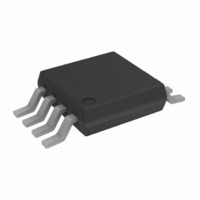ADA4891-2ARMZ Analog Devices Inc, ADA4891-2ARMZ Datasheet - Page 5

ADA4891-2ARMZ
Manufacturer Part Number
ADA4891-2ARMZ
Description
IC OPAMP GP R-R CMOS DUAL 8MSOP
Manufacturer
Analog Devices Inc
Datasheet
1.ADA4891-2ARMZ.pdf
(20 pages)
Specifications of ADA4891-2ARMZ
Slew Rate
210 V/µs
Amplifier Type
General Purpose
Number Of Circuits
2
Output Type
Rail-to-Rail
-3db Bandwidth
240MHz
Current - Input Bias
2pA
Voltage - Input Offset
2500µV
Current - Supply
4.4mA
Current - Output / Channel
150mA
Voltage - Supply, Single/dual (±)
2.7 V ~ 5.5 V, ±1.35 V ~ 2.75 V
Operating Temperature
-40°C ~ 125°C
Mounting Type
Surface Mount
Package / Case
8-MSOP, Micro8™, 8-uMAX, 8-uSOP,
Op Amp Type
High Speed
No. Of Amplifiers
2
Bandwidth
240MHz
Supply Voltage Range
2.7V To 5.5V
Amplifier Case Style
SO
No. Of Pins
8
Operating Temperature Range
-40°C To +125°C
Lead Free Status / RoHS Status
Lead free / RoHS Compliant
Gain Bandwidth Product
-
Lead Free Status / RoHS Status
Lead free / RoHS Compliant, Lead free / RoHS Compliant
Available stocks
Company
Part Number
Manufacturer
Quantity
Price
Part Number:
ADA4891-2ARMZ
Manufacturer:
ADI/亚德诺
Quantity:
20 000
ABSOLUTE MAXIMUM RATINGS
Table 3.
Parameter
Supply Voltage
Input Voltage (Common Mode)
Differential Input Voltage
Storage Temperature Range (R)
Operating Temperature Range (A Grade)
Lead Temperature (Soldering, 10 sec)
Stresses above those listed under Absolute Maximum Ratings
may cause permanent damage to the device. This is a stress
rating only; functional operation of the device at these or any
other conditions above those indicated in the operational
section of this specification is not implied. Exposure to absolute
maximum rating conditions for extended periods may affect
device reliability.
MAXIMUM POWER DISSIPATION
The maximum power that can be safely dissipated by the
ADA4891-1/ADA4891-2 is limited by the associated rise in
junction temperature. The maximum safe junction temperature
for plastic encapsulated devices is determined by the glass
transition temperature of the plastic, approximately 150°C.
Temporarily exceeding this limit can cause a shift in parametric
performance due to a change in the stresses exerted on the die
by the package. Exceeding a junction temperature of 175°C for
an extended period can result in device failure.
The still-air thermal properties of the package (θ
temperature (T
(P
The junction temperature can be calculated as
D
) can be used to determine the junction temperature of the die.
T
J
= T
A
+ (P
A
), and the total power dissipated in the package
D
× θ
JA
)
JA
Rating
6 V
−V
±V
−65°C to +125°C
−40°C to +125°C
300°C
), the ambient
S
S
− 0.5 V to +V
Rev. A | Page 5 of 20
(1)
S
The power dissipated in the package (P
quiescent power dissipation and the power dissipated in the
package due to the load drive for all outputs. It can be calculated by
where:
V
I
V
R
To ensure proper operating, it is necessary to observe the
maximum power derating curve in Figure 5, where it is derived
by setting T
safe power dissipation in the package vs. the ambient temperature
for the 5-lead SOT-23 (146°C/W), the 8-lead SOIC (115°C/W),
and the 8-Lead MSOP (133°C/W) on a JEDEC standard
4-layer board.
ESD CAUTION
S
L
S
OUT
is the quiescent current.
is the positive supply rail.
is the output load of the amplifier.
P
is the output of the amplifier.
Figure 5. Maximum Power Dissipation vs. Ambient Temperature
D
2.0
1.5
1.0
0.5
= (V
0
–55
J
= 150°C in Equation 1. Figure 5 shows the maximum
S
–35
× I
S
) + (V
5-LEAD SOT-23
–15
AMBIENT TEMPERAURE (°C)
S
5
− V
8-LEAD MSOP
ADA4891-1/ADA4891-2
OUT
25
) × V
8-LEAD SOIC
45
OUT
65
D
/R
) is the sum of the
L
85
T
105
J
= 150 °C
125
(2)












